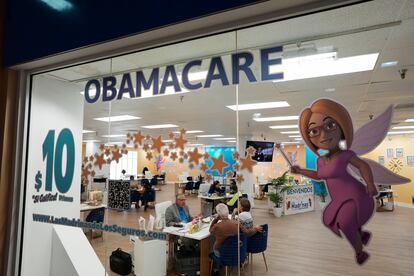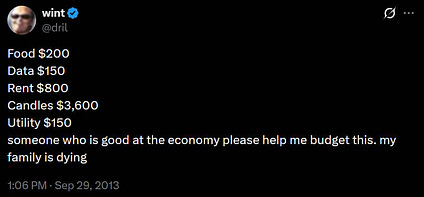Latinos cornered by Trump: Immigration crackdown and federal shutdown put families at risk – EL PAÍS English

Report on the Impact of the U.S. Government Shutdown on the Latino Community and Sustainable Development Goals
A partial shutdown of the United States government has placed essential services for the U.S. Latino population in jeopardy, creating significant setbacks for the achievement of several key Sustainable Development Goals (SDGs). The suspension of funding for crucial health and nutrition programs disproportionately affects this community, undermining progress on poverty reduction, food security, health, and equality.
Threats to Good Health and Well-being (SDG 3) and Reduced Inequalities (SDG 10)
The shutdown poses a direct threat to health infrastructure and access to care, which is critical for achieving SDG 3 (Good Health and Well-being). The Latino community is particularly vulnerable due to existing disparities, making this a significant challenge to SDG 10 (Reduced Inequalities).
- Healthcare Access: Negotiations to end the shutdown have stalled over proposed cuts to public health programs, including Medicaid and Medicare. Approximately 20 million Latinos, representing 30% of all beneficiaries, rely on Medicaid for healthcare coverage.
- Insurance Subsidies: The continuation of subsidies under the Affordable Care Act (ACA) is at risk. Over five million Latinos have gained insurance through the ACA marketplace. The loss of these subsidies could increase monthly insurance costs by an average of $1,000 for Latino families, forcing many to become uninsured.
- Service Disruptions: Telehealth services, on which an estimated two million Latinos depend, face disruption. With nearly 18% of non-elderly Latinos uninsured and 55% underinsured, interruptions to these services and community clinics will severely impact health outcomes.
Jeopardy to Zero Hunger (SDG 2)
The government shutdown directly threatens food security for millions, a clear regression from the objectives of SDG 2 (Zero Hunger).
- Supplemental Nutrition Assistance Program (SNAP): This program, which provides food assistance to low-income families, is at risk. An estimated 10 million Latinos rely on SNAP to feed their families.
- Special Supplemental Nutrition Program for Women, Infants, and Children (WIC): Funding shortfalls endanger WIC, which provides essential nutrition for pregnant women, new mothers, and young children. Three million Latinos are beneficiaries of this program.
The potential suspension of these programs creates uncertainty and hardship, making it more difficult for low-income households to access nutritious food.
Impact on No Poverty (SDG 1) and Decent Work and Economic Growth (SDG 8)
The economic consequences of the shutdown undermine efforts to eradicate poverty and ensure stable employment, affecting SDG 1 (No Poverty) and SDG 8 (Decent Work and Economic Growth).
- Federal Employment: Approximately 300,000 federal employees of Latino descent face the risk of going without pay. This loss of income directly impacts household financial stability and pushes vulnerable families toward poverty.
- Increased Financial Burden: The combination of lost wages for federal workers and potentially higher healthcare costs for millions places an immense financial strain on the community, counteracting poverty-reduction goals.
Challenges to Strong Institutions (SDG 16)
The political dysfunction leading to the government shutdown highlights a failure of effective and accountable institutions, as outlined in SDG 16 (Peace, Justice and Strong Institutions). The inability to maintain funding for essential public services demonstrates an institutional weakness that results in direct harm to vulnerable populations and exacerbates systemic inequalities, thereby impeding national progress toward the 2030 Agenda for Sustainable Development.
Analysis of Sustainable Development Goals in the Article
1. Which SDGs are addressed or connected to the issues highlighted in the article?
- SDG 1: No Poverty: The article discusses the financial instability faced by Latino federal workers who have gone without pay and the reliance of low-income families on government subsidies for basic needs. The shutdown jeopardizes the economic security of vulnerable populations, pushing them closer to poverty.
- SDG 2: Zero Hunger: The potential cuts and funding shortfalls for the Supplemental Nutrition Assistance Program (SNAP) and the Special Supplemental Nutrition Program for Women, Infants, and Children (WIC) are central themes. These programs are crucial for providing food security to millions of low-income Latino families.
- SDG 3: Good Health and Well-being: The article extensively covers the threats to public health programs like Medicaid, Medicare, and subsidies under the Affordable Care Act (ACA). It highlights how disruptions to these services would severely limit access to essential medical care for the Latino community, which already faces high rates of being uninsured or underinsured.
- SDG 10: Reduced Inequalities: The core argument of the article is that the government shutdown and proposed budget cuts disproportionately affect the Latino community. It points out inequalities in access to healthcare, economic stability, and food security based on ethnicity and economic status, and mentions the context of an “immigration crackdown, in which racial profiling has been endorsed.”
- SDG 16: Peace, Justice and Strong Institutions: The article describes the government shutdown as “Washington’s dysfunction” and a failure of institutions to function effectively. This institutional failure has direct, negative consequences on the well-being and rights of citizens, particularly the most vulnerable groups.
2. What specific targets under those SDGs can be identified based on the article’s content?
-
Under SDG 1 (No Poverty):
- Target 1.3: Implement nationally appropriate social protection systems and measures for all… and achieve substantial coverage of the poor and the vulnerable. The article discusses threats to social protection systems like SNAP, WIC, and Medicaid, which are essential for vulnerable Latino families.
-
Under SDG 2 (Zero Hunger):
- Target 2.1: By 2030, end hunger and ensure access by all people, in particular the poor and people in vulnerable situations, including infants, to safe, nutritious and sufficient food all year round. The article directly addresses this by highlighting the role of SNAP and WIC in providing food vouchers for millions of Latinos, including women and children.
-
Under SDG 3 (Good Health and Well-being):
- Target 3.8: Achieve universal health coverage, including financial risk protection, access to quality essential health-care services… for all. The discussion focuses on the ACA, Medicaid, and Medicare subsidies, which are critical for providing health coverage and protecting Latino families from “astronomical” medical bills.
-
Under SDG 10 (Reduced Inequalities):
- Target 10.2: By 2030, empower and promote the social, economic and political inclusion of all, irrespective of… race, ethnicity, origin… or economic or other status. The article shows how the shutdown is a direct assault on Latino families, threatening their social and economic inclusion.
- Target 10.3: Ensure equal opportunity and reduce inequalities of outcome, including by eliminating discriminatory… policies and practices. The article implies that the policies and the shutdown create an unequal outcome, as they “disproportionately affect Latinos” and hit them “hardest.”
-
Under SDG 16 (Peace, Justice and Strong Institutions):
- Target 16.6: Develop effective, accountable and transparent institutions at all levels. The article’s reference to the government shutdown as “Washington’s dysfunction” points to a failure of institutions to be effective and accountable to the citizens they serve.
3. Are there any indicators mentioned or implied in the article that can be used to measure progress towards the identified targets?
-
For SDG 1 & 10 (Poverty & Inequality):
- The number of Latino federal employees who have gone without pay (roughly 300,000).
- The total number of Latinos affected by the shutdown (more than 15 million).
-
For SDG 2 (Zero Hunger):
- The number of Latinos benefiting from the WIC program (3 million).
- The number of Latinos relying on the SNAP program (10 million).
-
For SDG 3 (Good Health and Well-being):
- The proportion of non-elderly Latinos who are uninsured (nearly 18%).
- The proportion of non-elderly Latinos who are underinsured (55%).
- The number of Latinos relying on Medicaid (about 20 million, representing 30% of all beneficiaries).
- The number of Latinos who have purchased insurance through the ACA marketplace (over five million).
- The potential increase in monthly health insurance costs for Latino families if subsidies are cut ($1,000 per month).
-
For SDG 16 (Strong Institutions):
- The duration of the partial government shutdown (on track to surpass the 34-day record). This serves as a direct indicator of institutional failure.
4. Table of SDGs, Targets, and Indicators
| SDGs | Targets | Indicators |
|---|---|---|
| SDG 1: No Poverty | 1.3: Implement nationally appropriate social protection systems. |
|
| SDG 2: Zero Hunger | 2.1: End hunger and ensure access to safe, nutritious and sufficient food. |
|
| SDG 3: Good Health and Well-being | 3.8: Achieve universal health coverage, including financial risk protection. |
|
| SDG 10: Reduced Inequalities | 10.2: Promote social, economic and political inclusion of all. 10.3: Ensure equal opportunity and reduce inequalities of outcome. |
|
| SDG 16: Peace, Justice and Strong Institutions | 16.6: Develop effective, accountable and transparent institutions. |
|
Source: english.elpais.com
What is Your Reaction?
 Like
0
Like
0
 Dislike
0
Dislike
0
 Love
0
Love
0
 Funny
0
Funny
0
 Angry
0
Angry
0
 Sad
0
Sad
0
 Wow
0
Wow
0
















































:focal(1500,1000)/https://media.globalcitizen.org/a6/9a/a69a4720-d8a1-4715-b596-18738d03c05c/rotary_polio_hero_image.jpg?#)







/countries/sri-lanka/photo-credit---dmc-sri-lanka.tmb-1200v.jpg?sfvrsn=dc298bcc_1#)


















